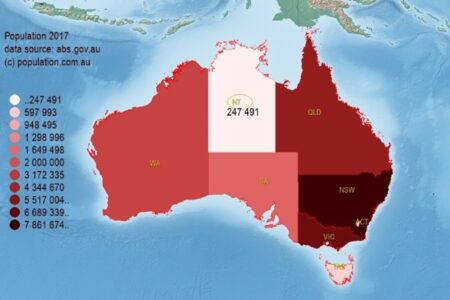
Figure 1
NT State Population (Source: https://images.app.goo.gl/mVia9Q8aQhxrdgsF8)
The details of our trip to Darwin were outlined in the first blog that I wrote in this series, that was posted three days after our return (July 25) and I’ll focus this blog on our Darwin trip and its environs. About 5 days were spent in an organized tour in the National Parks around Darwin, a map of which was included in that blog. They include Kakadu National Park, Litchfield National Park, and the Katherine Gorges.
Figures 1 and 2 provide a general picture. Darwin is the capital of the Northern Territory (NT). It is not a State because even the population of tiny Tasmania (that is a state) exceeds it by a factor of 2. Half of the population of NT is around Darwin; even with that, Darwin counts as a small city. Figure 2 indicates that at least in the dry season (see last week’s blog), the city and the parks around it are significant tourist draws. Indeed, walking around the city leaves the impression of a crowded place. Most of this blog will focus on a few photographs that we took during the visit.
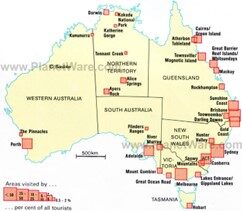
Figure 2
Australian tourist attractions (Source: https://www.worldmap1.com/australia-tourism-map)
Before shifting to the photographs, here are a few words (and sites) about the weather and about Kakadu National Park:
The Weather (Source: https://www.australia.com/en-us/facts-and-planning/weather-in-australia/darwin-weather.html):
The wet season (November – April)
The wet season in Darwin is characterized by high humidity, monsoonal rains and storms. Average temperatures range from 24.7 – 32 °C (76.5 – 89.6°F), and humidity can push past 80 per cent. The average annual rainfall is 1727.3 mm (68 inches) and January is the wettest month. Despite this, January and February is considered by many as the most beautiful time of year in the Top End. Sunny days and afternoon storms refresh the landscape, and animals and plants flourish.
October to December is the season of spectacular lightning storms, an event eagerly awaited by locals who watch the show from beachside restaurants and bars.
The dry season (May – October)
The dry season, from May until October, is characterized by warm, dry sunny days and cool nights. Temperatures typically range from 21.6– 31.8°C (70.9 – 89.2°F), and humidity levels are much lower: around 60 – 65 per cent.
Relatively cool weather arrives in May, and until July, nights are crisp with temperatures ranging from 17 – 23 °C (62.6 – 73.4°F). It is also the perfect time to explore the more remote areas of the region that can be off-limits during the wet season.
For contrast, the average annual precipitation in NYC is 46.6 inches (1184 mm).
Kakadu National Park (Source: https://en.wikipedia.org/wiki/Kakadu_National_Park)
Kakadu National Park is located within the Alligator Rivers Region of the Northern Territory, covering an area of 19,804 km2 (7,646 sq mi), extending nearly 200 kilometers (124 mi) from north to south and over 100 kilometers (62 mi) from east to west. It is roughly the size of Wales or one-third the size of Tasmania, and is the second-largest national park in Australia, after the Munga-Thirri–Simpson Desert National Park. Most of the region is owned by the Aboriginal traditional owners, who have occupied the land for around 60,000 years and, today, manage the park jointly with Parks Australia. It is highly ecologically and biologically diverse; hosting a wide range of habitats and flora and fauna, Kakadu is fully protected by the EPBC Act. It also includes a rich heritage of Aboriginal rock art, including highly significant sites, such as Ubirr.
All our friends on the tour of the national parks were Australian. We asked the guide if this is the norm. She responded that on the previous tour, there were a few Americans and Canadians. All of us were “traveling to the weather.” But all of us were aware that these are luxury travels that very few can afford. There is another kind of “weather traveler,” one for people that have no other option. We labeled these as “environmental refugees” and I’ve often written about this topic. (see April 3, 2018, e.g.). Most of us cannot escape the impacts of climate change. Recently, President Biden took some steps that include protections for construction workers, farmers and other laborers who are exposed to sweltering heat. All of us realize that much more needs to be done.
What follows are some pictorial highlights of the trip:
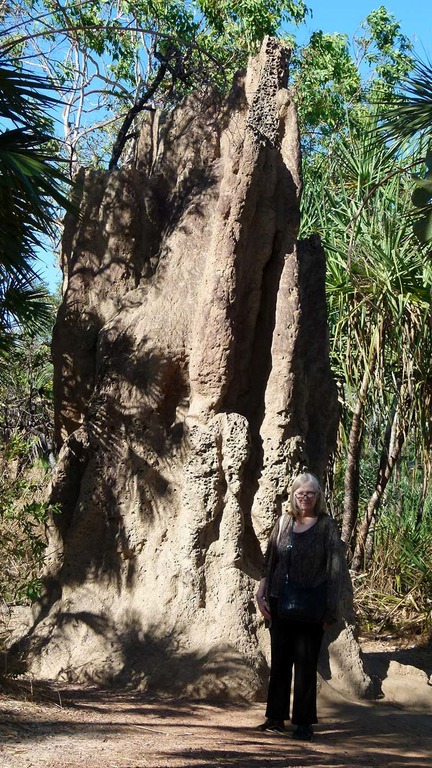
Figure 3
Louise near a Cathedral termite mound in Litchfield National Park
These mounds can last 50-60 years.
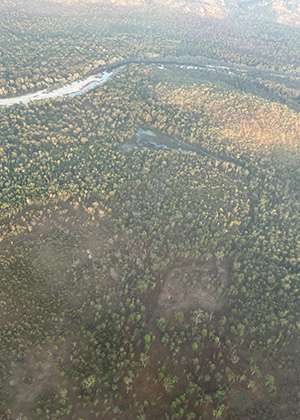
Figure 4
Kakadu National Park from above
The main conclusion that I draw from the landscape of Kakadu, is the power of water, with almost no human help or destruction, to enrich the landscape. We were given a warning about the river network: don’t swim in these rivers. The reason is shown in figure 5.

Figure 5
Crocodile ready for a meal in Kakadu National Park
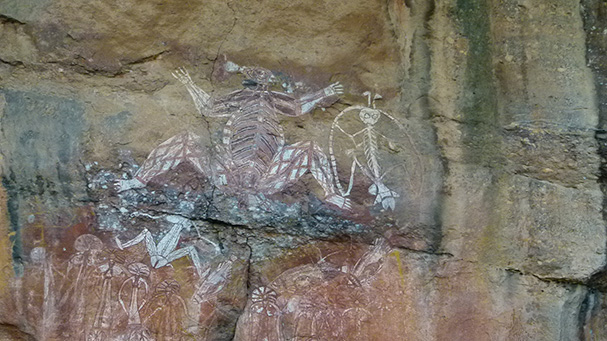
Figure 6
Ancient (≈ 12,500 years) cave drawings by Aboriginals in Kakadu National Park
More about the cave painting can be found here.
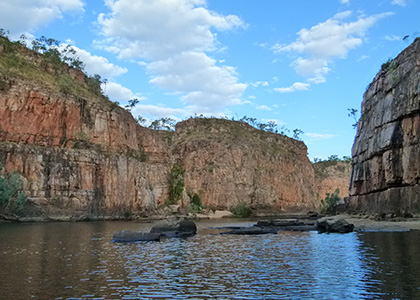
Figure 7
Katherine Gorge
We departed from Darwin with a gorgeous sunset as shown in figure 8.

Figure 8
Sunset in Darwin
One of the best opportunities to see the sunset is to walk on one of the beaches in the late afternoon where, twice a week, during the dry season, a sunset market takes place that invites all the attendees to watch the sunset (figure 9) after buying all kinds of stuff.

Figure 9
Observers of the Sunset from Darwin’s Sunset Sunday-Thursday market.

Thanks.
Your vivid descriptions and captivating photographs have truly transported me to the stunning landscapes of Darwin and its surrounding National Parks. Your account of the different weather patterns, from the wet to the dry season, provided a unique insight into the region’s climate. Your dedication to highlighting the intersection of climate, environment, and travel is both inspiring and enlightening. Your post has not only enriched my understanding of these issues but has also ignited a desire to explore these beautiful landscapes myself.